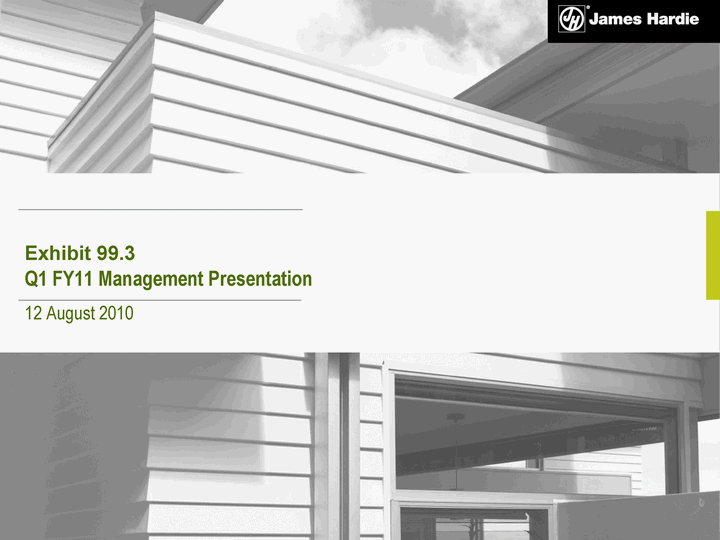

| Exhibit 99.3 Q1 FY11 Management Presentation 12 August 2010 |
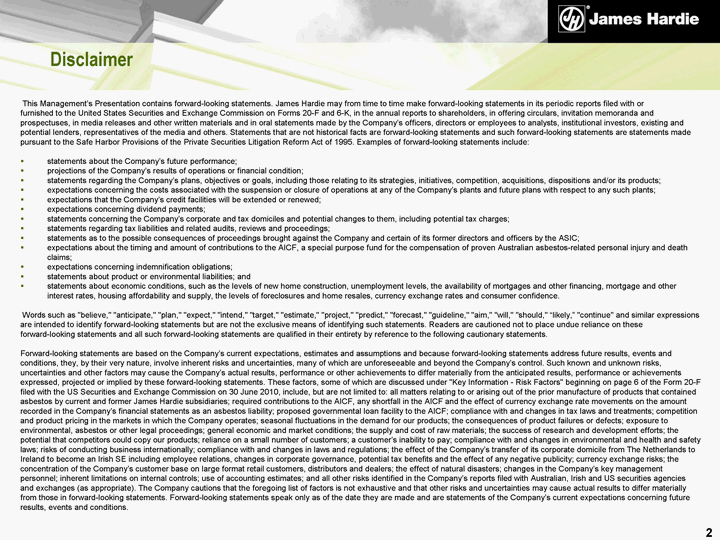
| Disclaimer This Management's Presentation contains forward-looking statements. James Hardie may from time to time make forward-looking statements in its periodic reports filed with or furnished to the United States Securities and Exchange Commission on Forms 20-F and 6-K, in the annual reports to shareholders, in offering circulars, invitation memoranda and prospectuses, in media releases and other written materials and in oral statements made by the Company's officers, directors or employees to analysts, institutional investors, existing and potential lenders, representatives of the media and others. Statements that are not historical facts are forward-looking statements and such forward-looking statements are statements made pursuant to the Safe Harbor Provisions of the Private Securities Litigation Reform Act of 1995. Examples of forward-looking statements include: statements about the Company's future performance; projections of the Company's results of operations or financial condition; statements regarding the Company's plans, objectives or goals, including those relating to its strategies, initiatives, competition, acquisitions, dispositions and/or its products; expectations concerning the costs associated with the suspension or closure of operations at any of the Company's plants and future plans with respect to any such plants; expectations that the Company's credit facilities will be extended or renewed; expectations concerning dividend payments; statements concerning the Company's corporate and tax domiciles and potential changes to them, including potential tax charges; statements regarding tax liabilities and related audits, reviews and proceedings; statements as to the possible consequences of proceedings brought against the Company and certain of its former directors and officers by the ASIC; expectations about the timing and amount of contributions to the AICF, a special purpose fund for the compensation of proven Australian asbestos-related personal injury and death claims; expectations concerning indemnification obligations; statements about product or environmental liabilities; and statements about economic conditions, such as the levels of new home construction, unemployment levels, the availability of mortgages and other financing, mortgage and other interest rates, housing affordability and supply, the levels of foreclosures and home resales, currency exchange rates and consumer confidence. Words such as "believe," "anticipate," "plan," "expect," "intend," "target," "estimate," "project," "predict," "forecast," "guideline," "aim," "will," "should," "likely," "continue" and similar expressions are intended to identify forward-looking statements but are not the exclusive means of identifying such statements. Readers are cautioned not to place undue reliance on these forward-looking statements and all such forward-looking statements are qualified in their entirety by reference to the following cautionary statements. Forward-looking statements are based on the Company's current expectations, estimates and assumptions and because forward-looking statements address future results, events and conditions, they, by their very nature, involve inherent risks and uncertainties, many of which are unforeseeable and beyond the Company's control. Such known and unknown risks, uncertainties and other factors may cause the Company's actual results, performance or other achievements to differ materially from the anticipated results, performance or achievements expressed, projected or implied by these forward-looking statements. These factors, some of which are discussed under "Key Information - Risk Factors" beginning on page 6 of the Form 20-F filed with the US Securities and Exchange Commission on 30 June 2010, include, but are not limited to: all matters relating to or arising out of the prior manufacture of products that contained asbestos by current and former James Hardie subsidiaries; required contributions to the AICF, any shortfall in the AICF and the effect of currency exchange rate movements on the amount recorded in the Company's financial statements as an asbestos liability; proposed governmental loan facility to the AICF; compliance with and changes in tax laws and treatments; competition and product pricing in the markets in which the Company operates; seasonal fluctuations in the demand for our products; the consequences of product failures or defects; exposure to environmental, asbestos or other legal proceedings; general economic and market conditions; the supply and cost of raw materials; the success of research and development efforts; the potential that competitors could copy our products; reliance on a small number of customers; a customer's inability to pay; compliance with and changes in environmental and health and safety laws; risks of conducting business internationally; compliance with and changes in laws and regulations; the effect of the Company's transfer of its corporate domicile from The Netherlands to Ireland to become an Irish SE including employee relations, changes in corporate governance, potential tax benefits and the effect of any negative publicity; currency exchange risks; the concentration of the Company's customer base on large format retail customers, distributors and dealers; the effect of natural disasters; changes in the Company's key management personnel; inherent limitations on internal controls; use of accounting estimates; and all other risks identified in the Company's reports filed with Australian, Irish and US securities agencies and exchanges (as appropriate). The Company cautions that the foregoing list of factors is not exhaustive and that other risks and uncertainties may cause actual results to differ materially from those in forward-looking statements. Forward-looking statements speak only as of the date they are made and are statements of the Company's current expectations concerning future results, events and conditions. 2 |
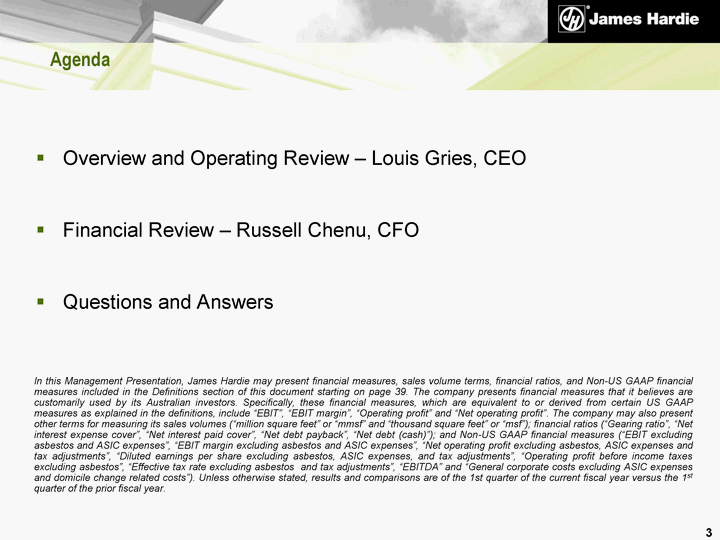
| Agenda Overview and Operating Review - Louis Gries, CEO Financial Review - Russell Chenu, CFO Questions and Answers 3 In this Management Presentation, James Hardie may present financial measures, sales volume terms, financial ratios, and Non-US GAAP financial measures included in the Definitions section of this document starting on page 39. The company presents financial measures that it believes are customarily used by its Australian investors. Specifically, these financial measures, which are equivalent to or derived from certain US GAAP measures as explained in the definitions, include "EBIT", "EBIT margin", "Operating profit" and "Net operating profit". The company may also present other terms for measuring its sales volumes ("million square feet" or "mmsf" and "thousand square feet" or "msf"); financial ratios ("Gearing ratio", "Net interest expense cover", "Net interest paid cover", "Net debt payback", "Net debt (cash)"); and Non-US GAAP financial measures ("EBIT excluding asbestos and ASIC expenses", "EBIT margin excluding asbestos and ASIC expenses", "Net operating profit excluding asbestos, ASIC expenses and tax adjustments", "Diluted earnings per share excluding asbestos, ASIC expenses, and tax adjustments", "Operating profit before income taxes excluding asbestos", "Effective tax rate excluding asbestos and tax adjustments", "EBITDA" and "General corporate costs excluding ASIC expenses and domicile change related costs"). Unless otherwise stated, results and comparisons are of the 1st quarter of the current fiscal year versus the 1st quarter of the prior fiscal year. |
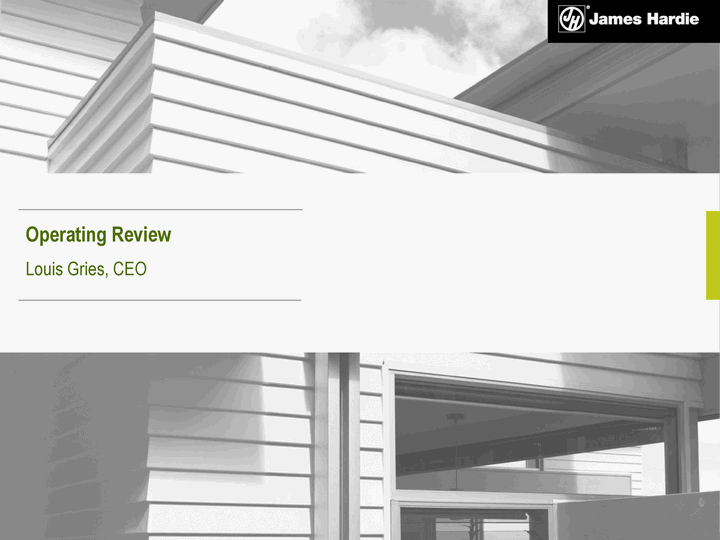
| Operating Review Louis Gries, CEO |

| Group Overview 1st Quarter operating results reflect a challenging US operating environment, higher input costs (particularly pulp and freight in the US), a strong positive contribution by the Asia Pacific businesses and lower corporate costs. The net operating result including asbestos, ASIC expenses and tax adjustments was primarily affected by a favourable asbestos adjustment of US$63.1m for the quarter which is attributable to the depreciation of the A$ against the US$. 5 |

| 1st Quarter Result Net Sales up 4% to US$233.0 million Sales Volume flat at 354.8 mmsf Average Price up 5% to US$657 per msf EBIT down 18% to US$56.1 million EBIT Margin down 6.7 pts to 24.1% 6 USA and Europe Fibre Cement |

| Average Net Sales Price US$ per MSF USA and Europe Fibre Cement US$657 7 |

| USA and Europe Fibre Cement * Excludes impairment charges of US$45.6 million in Q4 FY08 8 EBIT and EBIT Margin* EBIT EBIT Margin |
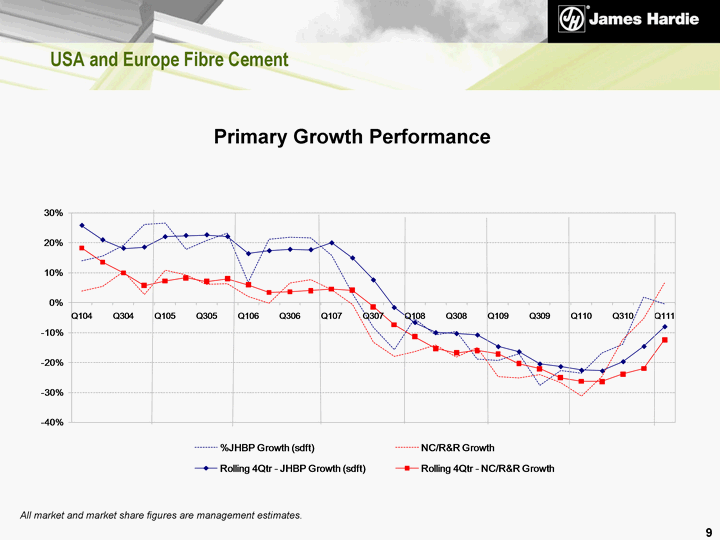
| USA and Europe Fibre Cement Primary Growth Performance All market and market share figures are management estimates. 9 |
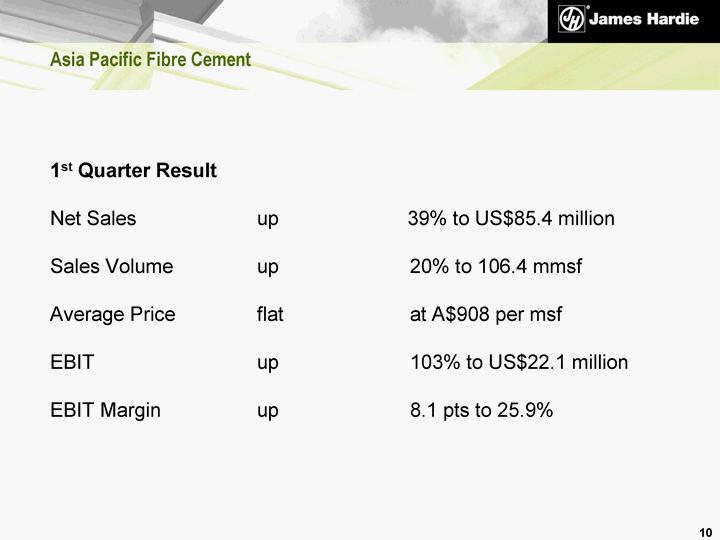
| 1st Quarter Result Net Sales up 39% to US$85.4 million Sales Volume up 20% to 106.4 mmsf Average Price flat at A$908 per msf EBIT up 103% to US$22.1 million EBIT Margin up 8.1 pts to 25.9% 10 Asia Pacific Fibre Cement |
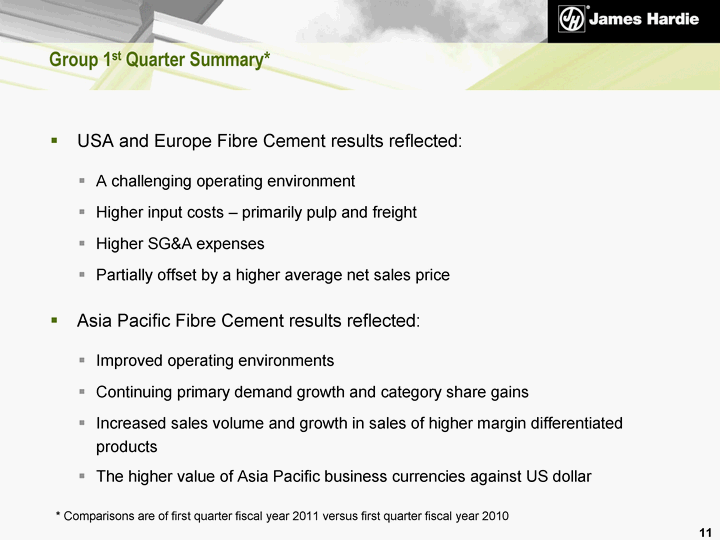
| USA and Europe Fibre Cement results reflected: A challenging operating environment Higher input costs - primarily pulp and freight Higher SG&A expenses Partially offset by a higher average net sales price Asia Pacific Fibre Cement results reflected: Improved operating environments Continuing primary demand growth and category share gains Increased sales volume and growth in sales of higher margin differentiated products The higher value of Asia Pacific business currencies against US dollar 11 Group 1st Quarter Summary* * Comparisons are of first quarter fiscal year 2011 versus first quarter fiscal year 2010 |
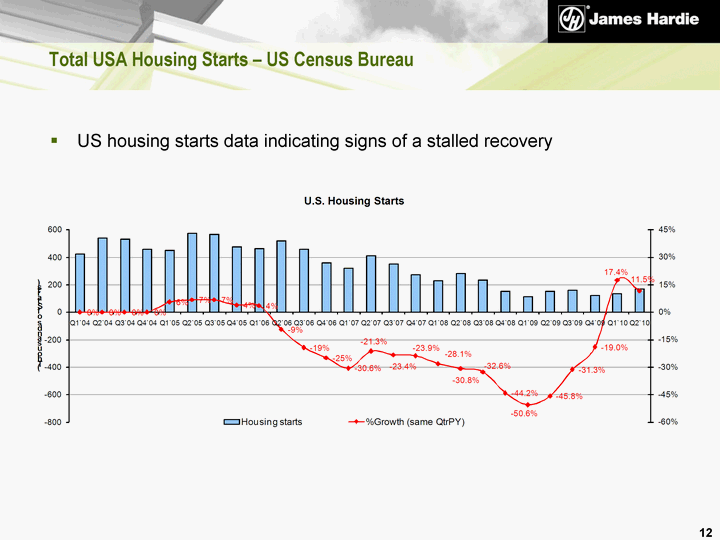
| 12 US housing starts data indicating signs of a stalled recovery Total USA Housing Starts - US Census Bureau |
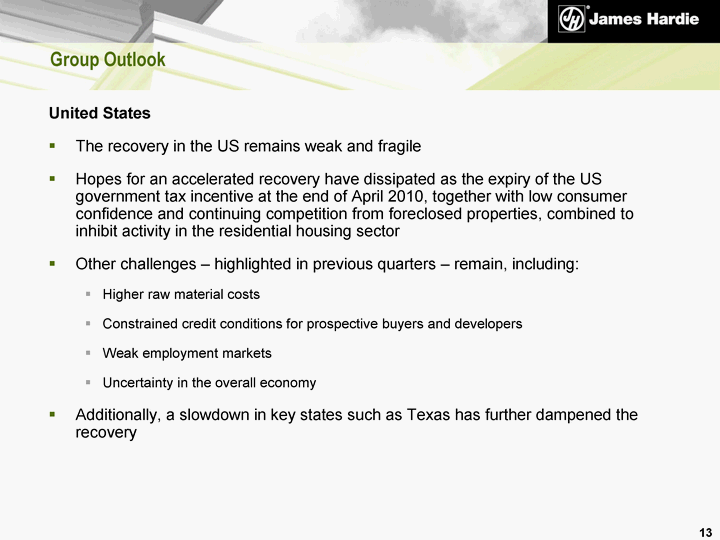
| United States The recovery in the US remains weak and fragile Hopes for an accelerated recovery have dissipated as the expiry of the US government tax incentive at the end of April 2010, together with low consumer confidence and continuing competition from foreclosed properties, combined to inhibit activity in the residential housing sector Other challenges - highlighted in previous quarters - remain, including: Higher raw material costs Constrained credit conditions for prospective buyers and developers Weak employment markets Uncertainty in the overall economy Additionally, a slowdown in key states such as Texas has further dampened the recovery Group Outlook 13 |

| Asia Pacific The residential housing markets in Australia, New Zealand and the Philippines are expected to maintain their underlying strength in fiscal year 2011 Softness in the renovation and commercial markets is expected to offset a significant portion of the stronger new housing growth Group Strategy The company remains focused on: Delivering primary demand growth Continuing to shift to a higher value product mix Achieving its zero to landfill objective Building the operational strength and flexibility to deliver and sustain earnings in a low-demand environment or increase output should a stronger than expected recovery eventuate 14 Group Outlook |
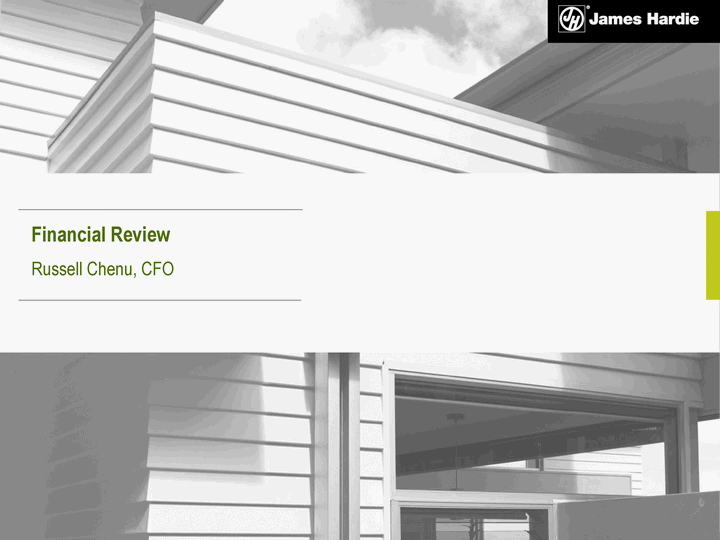
| Financial Review Russell Chenu, CFO |
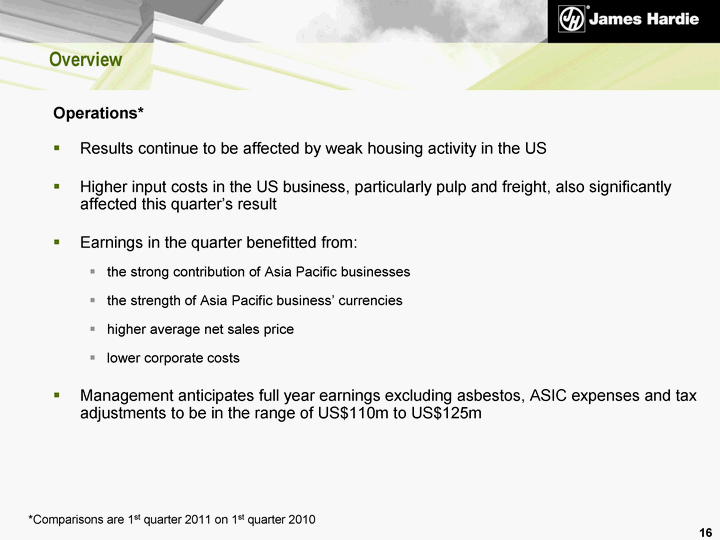
| Overview Operations* Results continue to be affected by weak housing activity in the US Higher input costs in the US business, particularly pulp and freight, also significantly affected this quarter's result Earnings in the quarter benefitted from: the strong contribution of Asia Pacific businesses the strength of Asia Pacific business' currencies higher average net sales price lower corporate costs Management anticipates full year earnings excluding asbestos, ASIC expenses and tax adjustments to be in the range of US$110m to US$125m 16 *Comparisons are 1st quarter 2011 on 1st quarter 2010 |
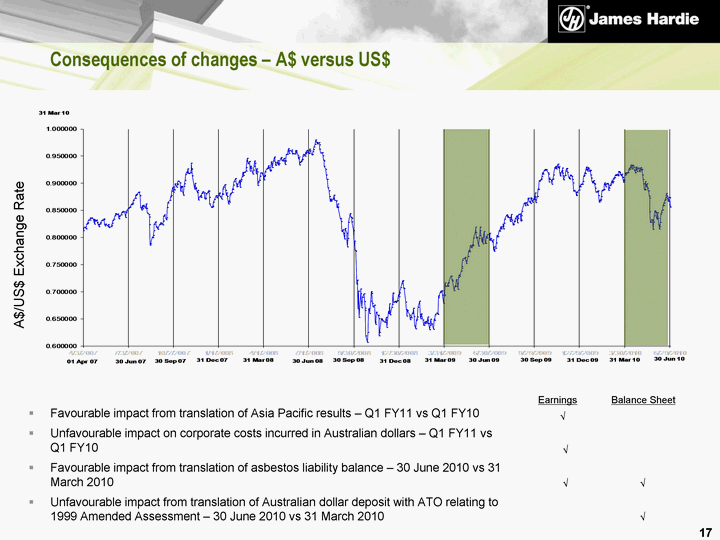
| Consequences of changes - A$ versus US$ A$/US$ Exchange Rate Favourable impact from translation of Asia Pacific results - Q1 FY11 vs Q1 FY10 Unfavourable impact on corporate costs incurred in Australian dollars - Q1 FY11 vs Q1 FY10 Favourable impact from translation of asbestos liability balance - 30 June 2010 vs 31 March 2010 Unfavourable impact from translation of Australian dollar deposit with ATO relating to 1999 Amended Assessment - 30 June 2010 vs 31 March 2010 17 Earnings Balance Sheet ^ ^ ^ ^ ^ |
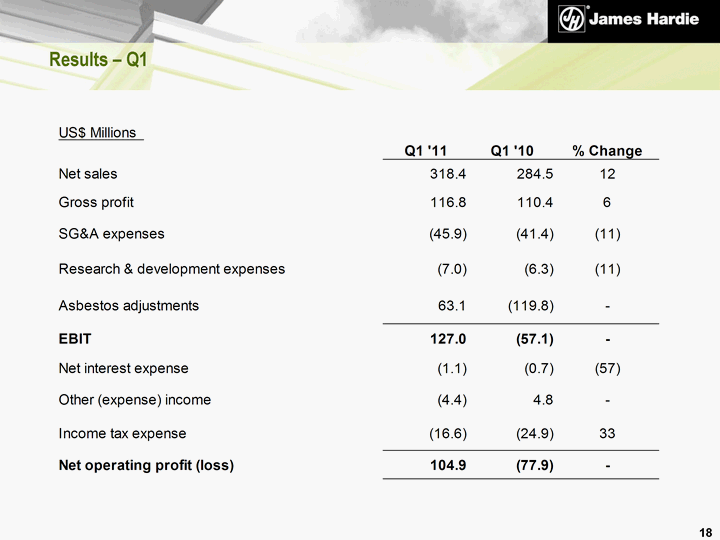
| Results - Q1 18 |
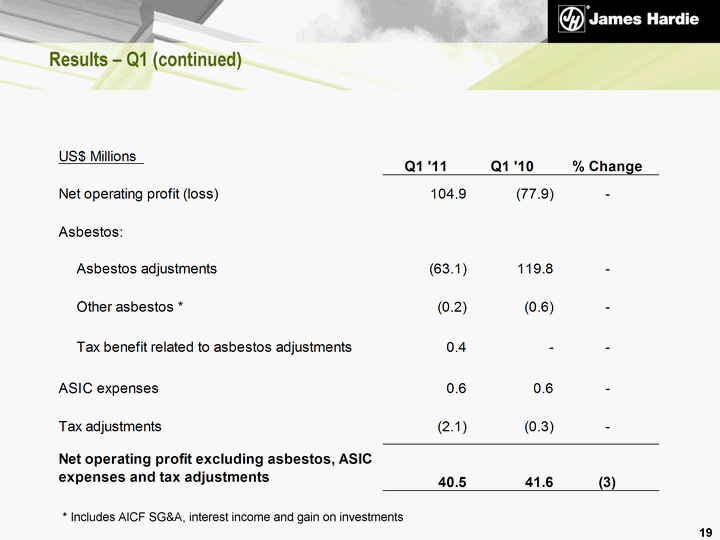
| Results - Q1 (continued) 19 * Includes AICF SG&A, interest income and gain on investments |
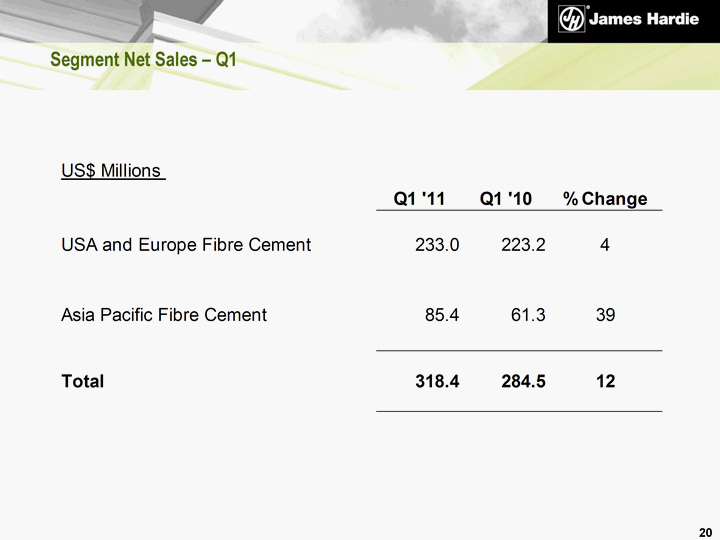
| Segment Net Sales - Q1 20 |
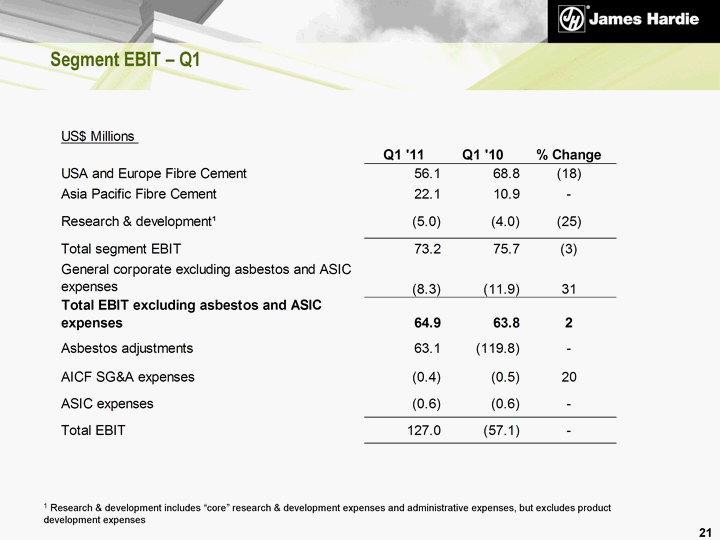
| 1 Research & development includes "core" research & development expenses and administrative expenses, but excludes product development expenses Segment EBIT - Q1 21 |
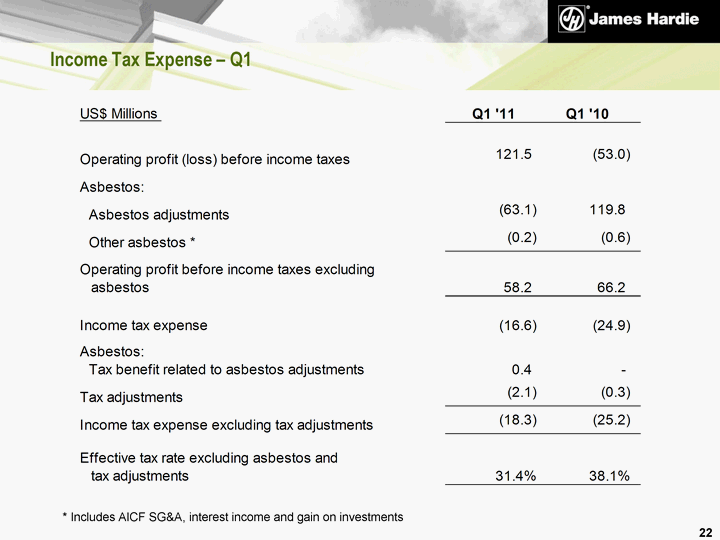
| Income Tax Expense - Q1 22 * Includes AICF SG&A, interest income and gain on investments |
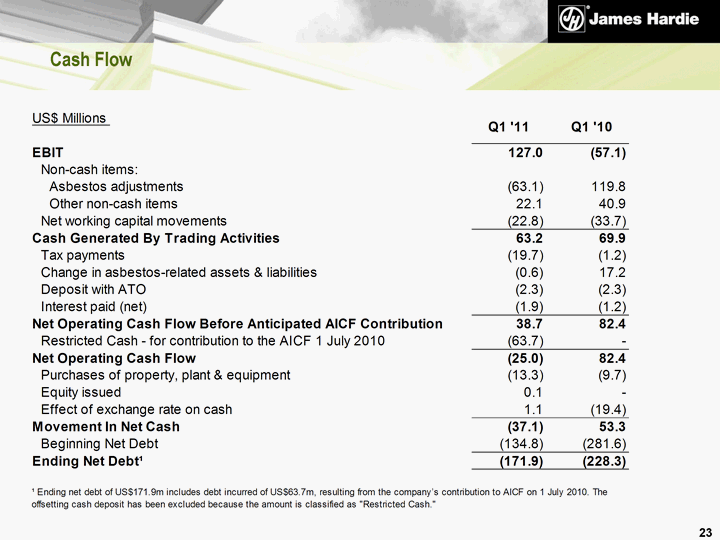
| Cash Flow 23 |
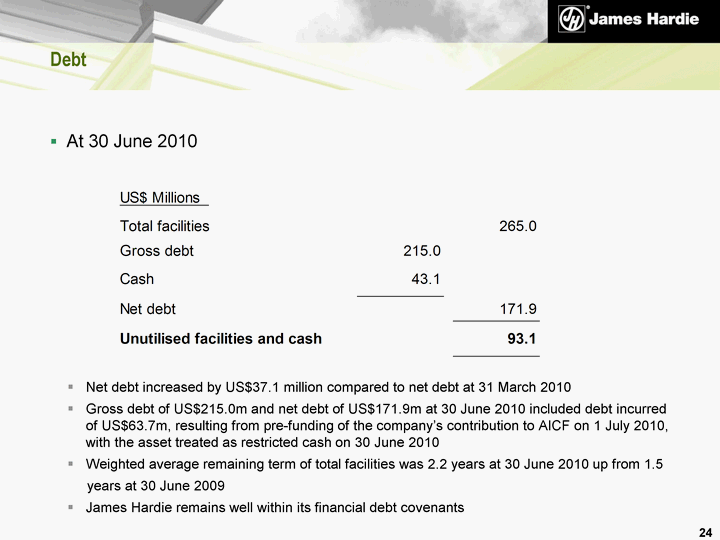
| Debt Net debt increased by US$37.1 million compared to net debt at 31 March 2010 Gross debt of US$215.0m and net debt of US$171.9m at 30 June 2010 included debt incurred of US$63.7m, resulting from pre-funding of the company's contribution to AICF on 1 July 2010, with the asset treated as restricted cash on 30 June 2010 Weighted average remaining term of total facilities was 2.2 years at 30 June 2010 up from 1.5 years at 30 June 2009 James Hardie remains well within its financial debt covenants 24 At 30 June 2010 |
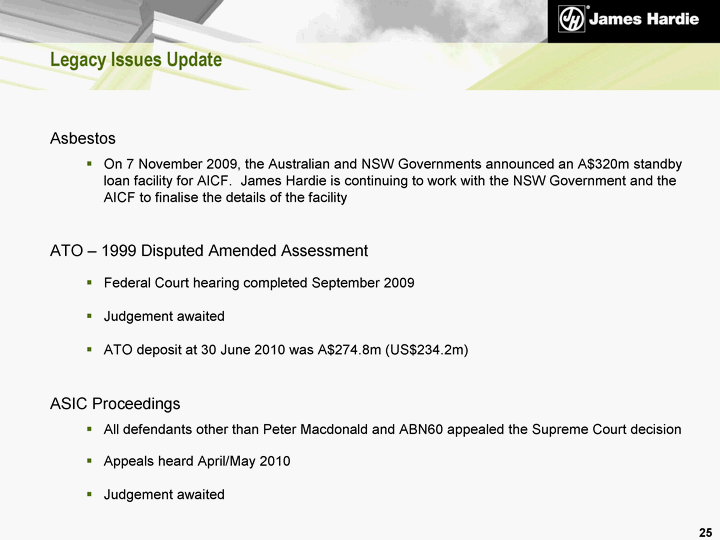
| Legacy Issues Update Asbestos On 7 November 2009, the Australian and NSW Governments announced an A$320m standby loan facility for AICF. James Hardie is continuing to work with the NSW Government and the AICF to finalise the details of the facility ATO - 1999 Disputed Amended Assessment Federal Court hearing completed September 2009 Judgement awaited ATO deposit at 30 June 2010 was A$274.8m (US$234.2m) ASIC Proceedings All defendants other than Peter Macdonald and ABN60 appealed the Supreme Court decision Appeals heard April/May 2010 Judgement awaited 25 |
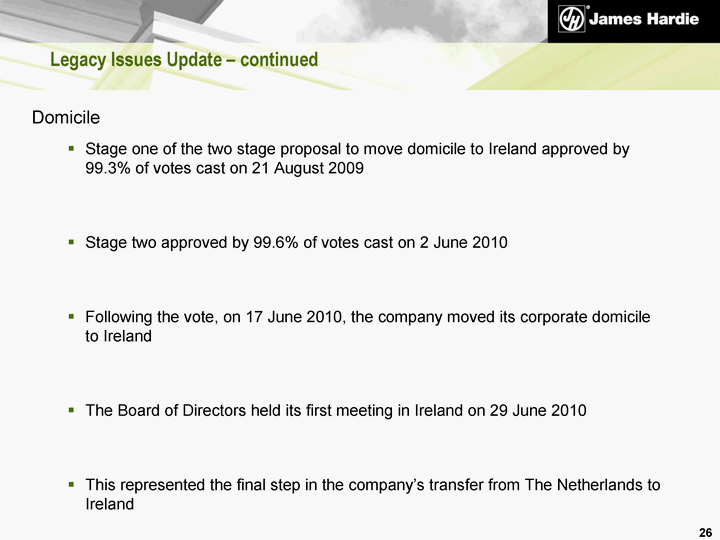
| Legacy Issues Update - continued Domicile Stage one of the two stage proposal to move domicile to Ireland approved by 99.3% of votes cast on 21 August 2009 Stage two approved by 99.6% of votes cast on 2 June 2010 Following the vote, on 17 June 2010, the company moved its corporate domicile to Ireland The Board of Directors held its first meeting in Ireland on 29 June 2010 This represented the final step in the company's transfer from The Netherlands to Ireland 26 |
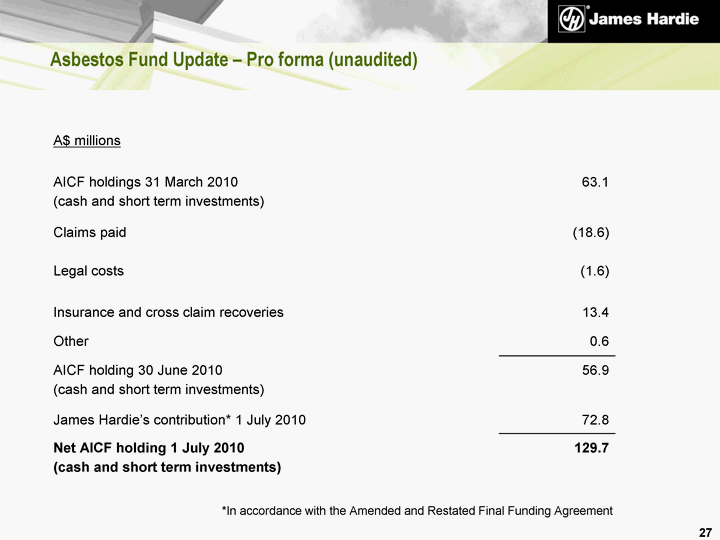
| Asbestos Fund Update - Pro forma (unaudited) 27 *In accordance with the Amended and Restated Final Funding Agreement A$ millions AICF holdings 31 March 2010 (cash and short term investments) 63.1 Claims paid (18.6) Legal costs (1.6) Insurance and cross claim recoveries 13.4 Other 0.6 AICF holding 30 June 2010 (cash and short term investments) 56.9 James Hardie's contribution* 1 July 2010 72.8 Net AICF holding 1 July 2010 (cash and short term investments) 129.7 |
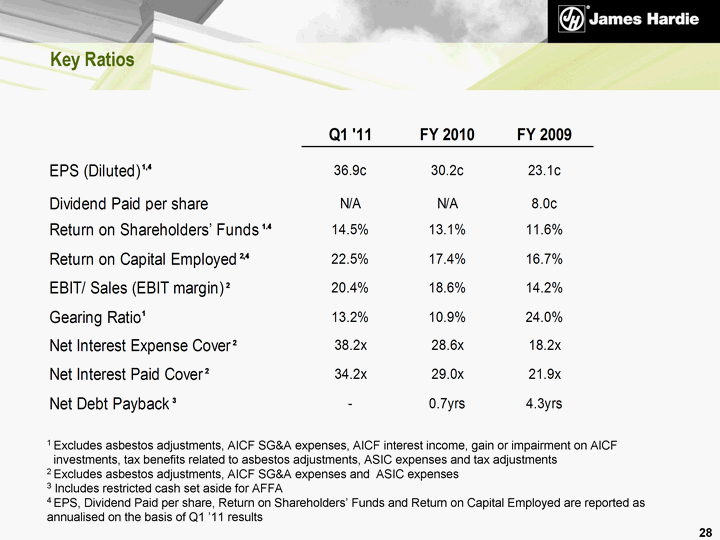
| Key Ratios 1 Excludes asbestos adjustments, AICF SG&A expenses, AICF interest income, gain or impairment on AICF investments, tax benefits related to asbestos adjustments, ASIC expenses and tax adjustments 2 Excludes asbestos adjustments, AICF SG&A expenses and ASIC expenses 3 Includes restricted cash set aside for AFFA 4 EPS, Dividend Paid per share, Return on Shareholders' Funds and Return on Capital Employed are reported as annualised on the basis of Q1 '11 results 28 |
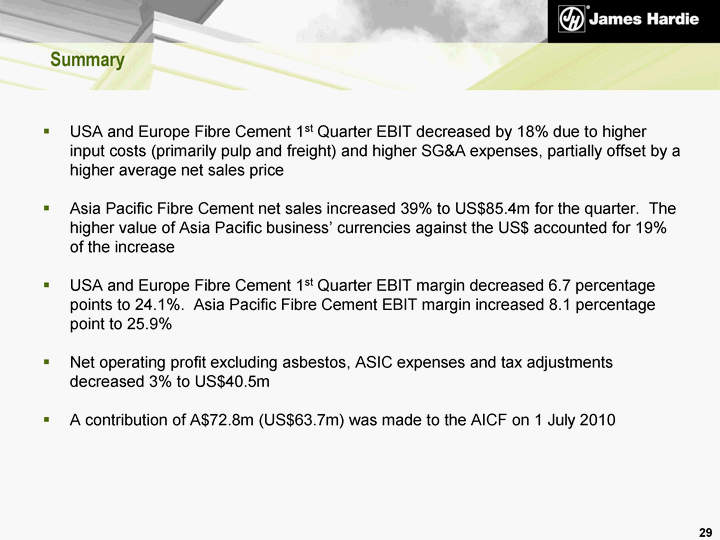
| 29 USA and Europe Fibre Cement 1st Quarter EBIT decreased by 18% due to higher input costs (primarily pulp and freight) and higher SG&A expenses, partially offset by a higher average net sales price Asia Pacific Fibre Cement net sales increased 39% to US$85.4m for the quarter. The higher value of Asia Pacific business' currencies against the US$ accounted for 19% of the increase USA and Europe Fibre Cement 1st Quarter EBIT margin decreased 6.7 percentage points to 24.1%. Asia Pacific Fibre Cement EBIT margin increased 8.1 percentage point to 25.9% Net operating profit excluding asbestos, ASIC expenses and tax adjustments decreased 3% to US$40.5m A contribution of A$72.8m (US$63.7m) was made to the AICF on 1 July 2010 Summary |
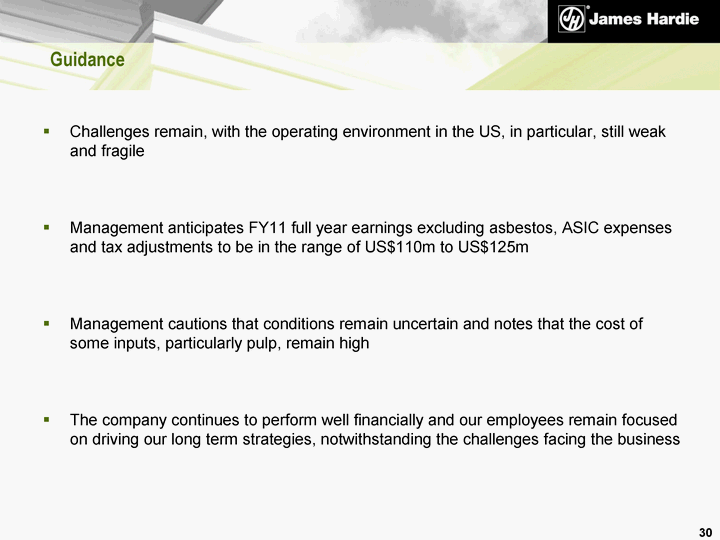
| 30 Challenges remain, with the operating environment in the US, in particular, still weak and fragile Management anticipates FY11 full year earnings excluding asbestos, ASIC expenses and tax adjustments to be in the range of US$110m to US$125m Management cautions that conditions remain uncertain and notes that the cost of some inputs, particularly pulp, remain high The company continues to perform well financially and our employees remain focused on driving our long term strategies, notwithstanding the challenges facing the business Guidance |

| Questions and Answers |

| Appendix |
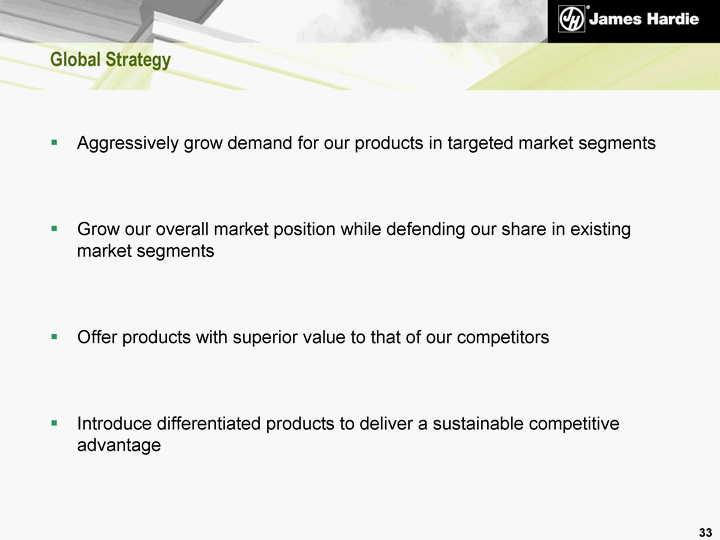
| Aggressively grow demand for our products in targeted market segments Grow our overall market position while defending our share in existing market segments Offer products with superior value to that of our competitors Introduce differentiated products to deliver a sustainable competitive advantage 33 Global Strategy |
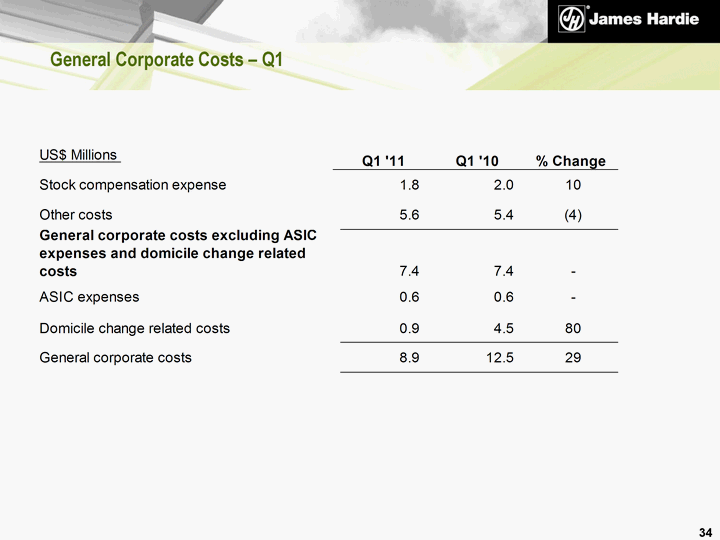
| General Corporate Costs - Q1 34 |
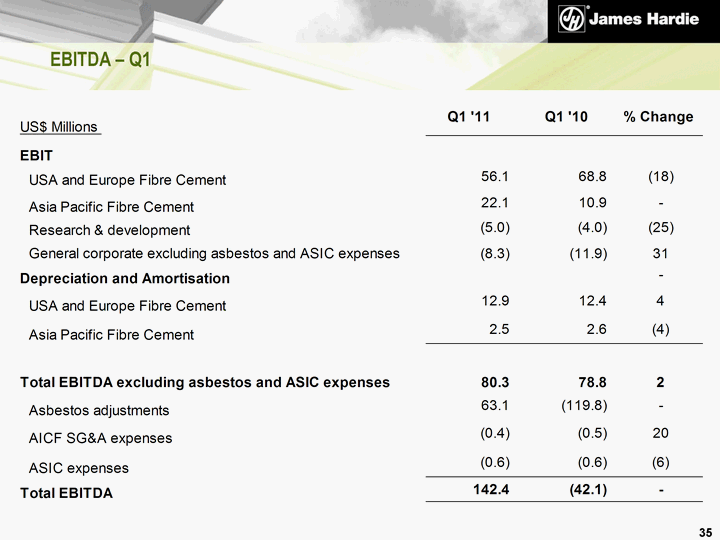
| EBITDA - Q1 35 |
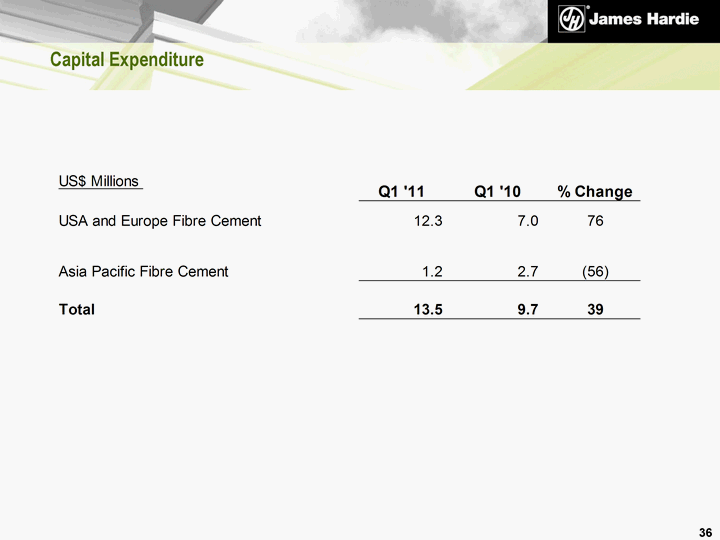
| Capital Expenditure 36 |
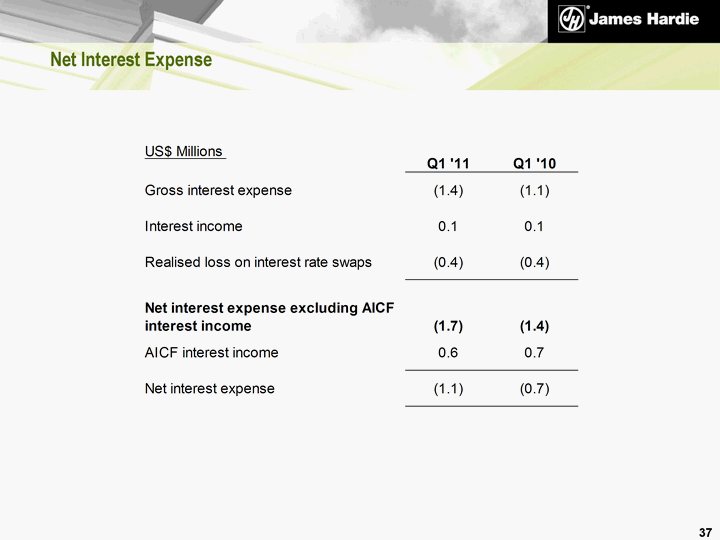
| Net Interest Expense 37 |
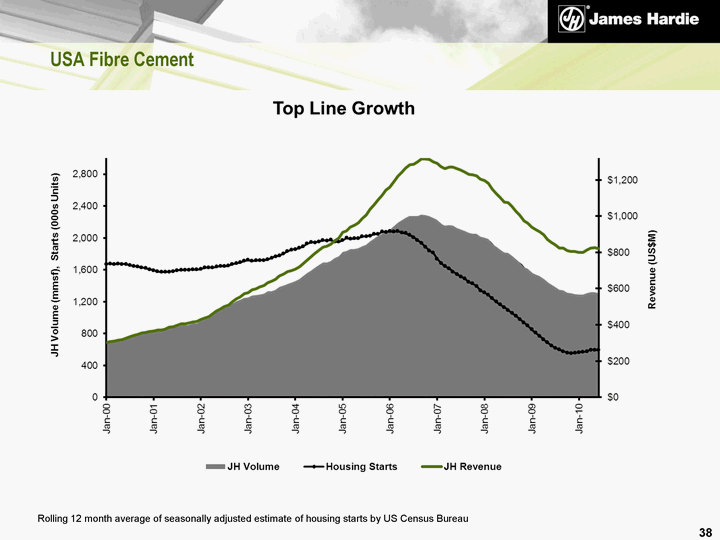
| USA Fibre Cement Rolling 12 month average of seasonally adjusted estimate of housing starts by US Census Bureau 38 |
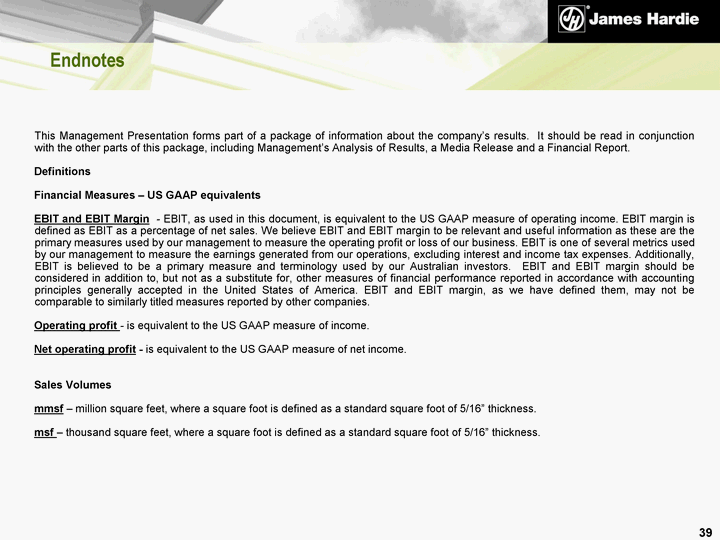
| Endnotes This Management Presentation forms part of a package of information about the company's results. It should be read in conjunction with the other parts of this package, including Management's Analysis of Results, a Media Release and a Financial Report. Definitions Financial Measures - US GAAP equivalents EBIT and EBIT Margin - EBIT, as used in this document, is equivalent to the US GAAP measure of operating income. EBIT margin is defined as EBIT as a percentage of net sales. We believe EBIT and EBIT margin to be relevant and useful information as these are the primary measures used by our management to measure the operating profit or loss of our business. EBIT is one of several metrics used by our management to measure the earnings generated from our operations, excluding interest and income tax expenses. Additionally, EBIT is believed to be a primary measure and terminology used by our Australian investors. EBIT and EBIT margin should be considered in addition to, but not as a substitute for, other measures of financial performance reported in accordance with accounting principles generally accepted in the United States of America. EBIT and EBIT margin, as we have defined them, may not be comparable to similarly titled measures reported by other companies. Operating profit - is equivalent to the US GAAP measure of income. Net operating profit - is equivalent to the US GAAP measure of net income. Sales Volumes mmsf - million square feet, where a square foot is defined as a standard square foot of 5/16" thickness. msf - thousand square feet, where a square foot is defined as a standard square foot of 5/16" thickness. 39 |
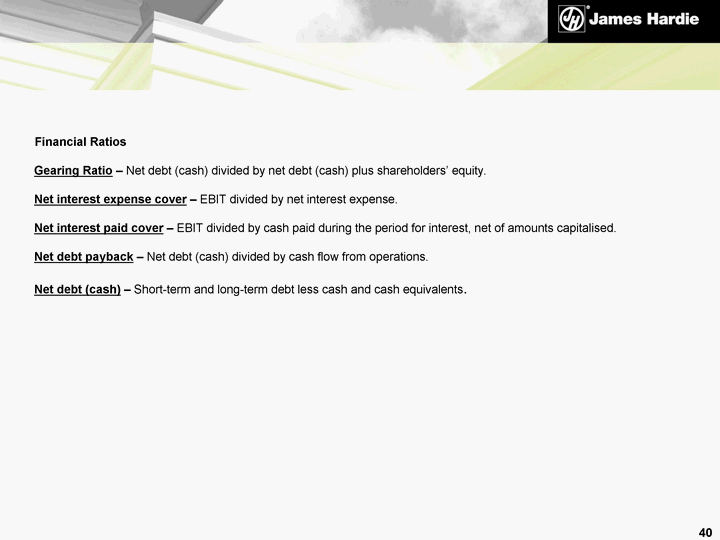
| Financial Ratios Gearing Ratio - Net debt (cash) divided by net debt (cash) plus shareholders' equity. Net interest expense cover - EBIT divided by net interest expense. Net interest paid cover - EBIT divided by cash paid during the period for interest, net of amounts capitalised. Net debt payback - Net debt (cash) divided by cash flow from operations. Net debt (cash) - Short-term and long-term debt less cash and cash equivalents. 40 |
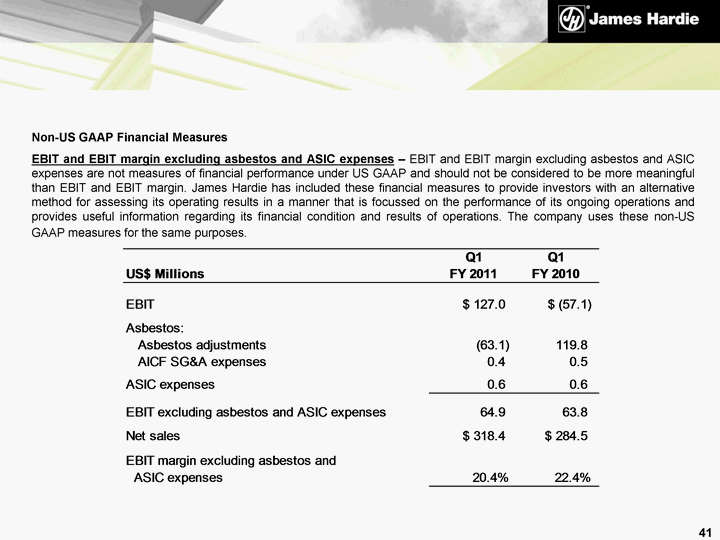
| Non-US GAAP Financial Measures EBIT and EBIT margin excluding asbestos and ASIC expenses - EBIT and EBIT margin excluding asbestos and ASIC expenses are not measures of financial performance under US GAAP and should not be considered to be more meaningful than EBIT and EBIT margin. James Hardie has included these financial measures to provide investors with an alternative method for assessing its operating results in a manner that is focussed on the performance of its ongoing operations and provides useful information regarding its financial condition and results of operations. The company uses these non-US GAAP measures for the same purposes. 41 |

| Non-US GAAP Financial Measures (continued) Net operating profit excluding asbestos, ASIC expenses and tax adjustments - Net operating profit excluding asbestos, ASIC expenses and tax adjustments is not a measure of financial performance under US GAAP and should not be considered to be more meaningful than net income. The company has included this financial measure to provide investors with an alternative method for assessing its operating results in a manner that is focussed on the performance of its ongoing operations. The company uses this non-US GAAP measure for the same purposes. 42 |
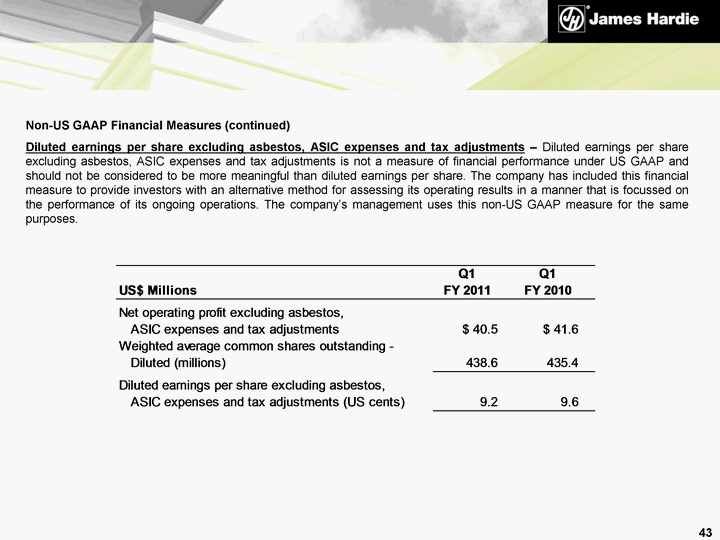
| Non-US GAAP Financial Measures (continued) Diluted earnings per share excluding asbestos, ASIC expenses and tax adjustments - Diluted earnings per share excluding asbestos, ASIC expenses and tax adjustments is not a measure of financial performance under US GAAP and should not be considered to be more meaningful than diluted earnings per share. The company has included this financial measure to provide investors with an alternative method for assessing its operating results in a manner that is focussed on the performance of its ongoing operations. The company's management uses this non-US GAAP measure for the same purposes. 43 |
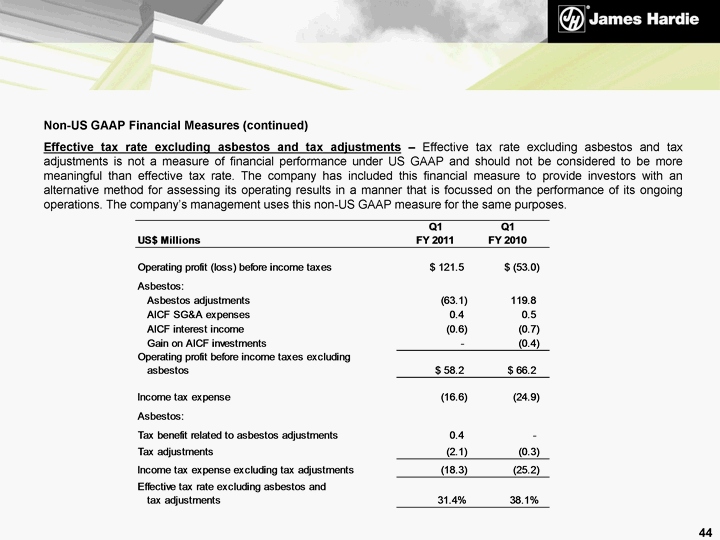
| Non-US GAAP Financial Measures (continued) Effective tax rate excluding asbestos and tax adjustments - Effective tax rate excluding asbestos and tax adjustments is not a measure of financial performance under US GAAP and should not be considered to be more meaningful than effective tax rate. The company has included this financial measure to provide investors with an alternative method for assessing its operating results in a manner that is focussed on the performance of its ongoing operations. The company's management uses this non-US GAAP measure for the same purposes. 44 |
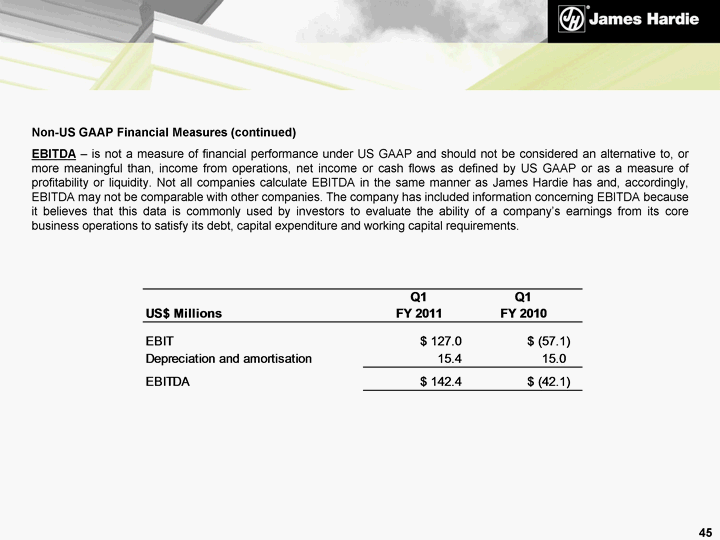
| Non-US GAAP Financial Measures (continued) EBITDA - is not a measure of financial performance under US GAAP and should not be considered an alternative to, or more meaningful than, income from operations, net income or cash flows as defined by US GAAP or as a measure of profitability or liquidity. Not all companies calculate EBITDA in the same manner as James Hardie has and, accordingly, EBITDA may not be comparable with other companies. The company has included information concerning EBITDA because it believes that this data is commonly used by investors to evaluate the ability of a company's earnings from its core business operations to satisfy its debt, capital expenditure and working capital requirements. 45 |

| Non-US GAAP Financial Measures (continued) General corporate costs excluding ASIC expenses and domicile change related costs - General corporate costs excluding ASIC expenses and domicile change related costs is not a measure of financial performance under US GAAP and should not be considered to be more meaningful than general corporate costs. James Hardie has included these financial measures to provide investors with an alternative method for assessing its operating results in a manner that is focussed on the performance of its ongoing operations and provides useful information regarding its financial condition and results of operations. The company uses these non-US GAAP measures for the same purposes. 46 |
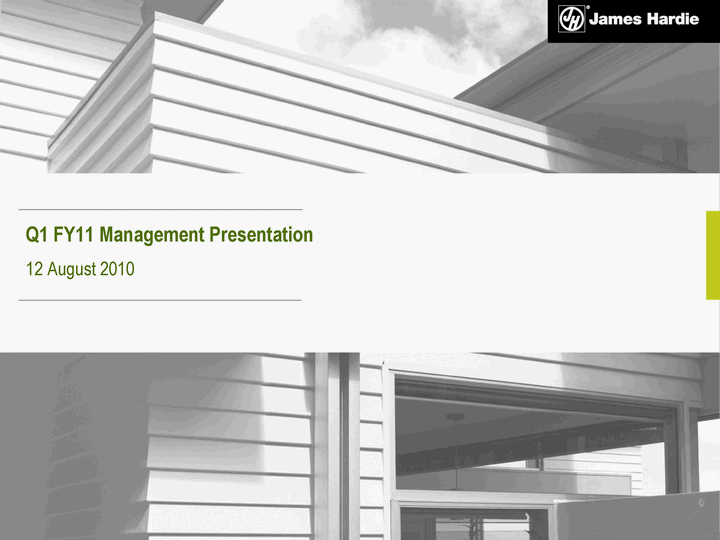
| Q1 FY11 Management Presentation 12 August 2010 |